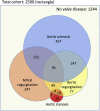Large-scale community echocardiographic screening reveals a major burden of undiagnosed valvular heart disease in older people: the OxVALVE Population Cohort Study
- PMID: 27354049
- PMCID: PMC5216199
- DOI: 10.1093/eurheartj/ehw229
Large-scale community echocardiographic screening reveals a major burden of undiagnosed valvular heart disease in older people: the OxVALVE Population Cohort Study
Abstract
Background: Valvular heart disease (VHD) is expected to become more common as the population ages. However, current estimates of its natural history and prevalence are based on historical studies with potential sources of bias. We conducted a cross-sectional analysis of the clinical and epidemiological characteristics of VHD identified at recruitment of a large cohort of older people.
Methods and results: We enrolled 2500 individuals aged ≥65 years from a primary care population and screened for undiagnosed VHD using transthoracic echocardiography. Newly identified (predominantly mild) VHD was detected in 51% of participants. The most common abnormalities were aortic sclerosis (34%), mitral regurgitation (22%), and aortic regurgitation (15%). Aortic stenosis was present in 1.3%. The likelihood of undiagnosed VHD was two-fold higher in the two most deprived socioeconomic quintiles than in the most affluent quintile, and three-fold higher in individuals with atrial fibrillation. Clinically significant (moderate or severe) undiagnosed VHD was identified in 6.4%. In addition, 4.9% of the cohort had pre-existing VHD (a total prevalence of 11.3%). Projecting these findings using population data, we estimate that the prevalence of clinically significant VHD will double before 2050.
Conclusions: Previously undetected VHD affects 1 in 2 of the elderly population and is more common in lower socioeconomic classes. These unique data demonstrate the contemporary clinical and epidemiological characteristics of VHD in a large population-based cohort of older people and confirm the scale of the emerging epidemic of VHD, with widespread implications for clinicians and healthcare resources.
Keywords: Echocardiography; Epidemiology; Health policy and outcome research; Valvular heart disease.
Published on behalf of the European Society of Cardiology. All rights reserved. © The Author 2016. For permissions please email: journals.permissions@oup.com.
Figures




Comment in
-
Valvular heart disease in older adults: seeking an ounce of prevention.Eur Heart J. 2016 Dec 14;37(47):3523-3524. doi: 10.1093/eurheartj/ehw354. Epub 2016 Sep 1. Eur Heart J. 2016. PMID: 27590452 Free PMC article. No abstract available.
-
Growing importance of valvular heart disease in the elderly.J Thorac Dis. 2016 Dec;8(12):E1701-E1703. doi: 10.21037/jtd.2016.12.23. J Thorac Dis. 2016. PMID: 28149618 Free PMC article. No abstract available.
References
-
- d'Arcy JL, Prendergast BD, Chambers JB, Ray SG, Bridgewater B. Valvular heart disease: the next cardiac epidemic. Heart 2011;97:91–93. - PubMed
-
- Vahanian A, Alfieri O, Andreotti F, Antunes MJ, Barón-Esquivias G, Baumgartner H, Borger MA, Carrel TP, De Bonis M, Evangelista A, Falk V, Iung B, Lancellotti P, Pierard L, Price S, Schäfers H-J, Schuler G, Stepinska J, Swedberg K, Takkenberg J, Von Oppell UO, Windecker S, Zamorano JL, Zembala M. Guidelines on the management of valvular heart disease (version 2012): The Joint Task Force on the Management of Valvular Heart Disease of the European Society of Cardiology (ESC) and the European Association for Cardio-Thoracic Surgery (EACTS). Eur Heart J 2012;33:2451–2496. - PubMed
-
- Iung B, Baron G, Butchart EG, Delahaye F, Gohlke-Bärwolf C, Levang OW, Tornos P, Vanoverschelde J-L, Vermeer F, Boersma E, Ravaud P, Vahanian A. A prospective survey of patients with valvular heart disease in Europe: The Euro Heart Survey on Valvular Heart Disease. Eur Heart J 2003;24:1231–1243. - PubMed
-
- Nkomo VT, Gardin JM, Skelton TN, Gottdiener JS, Scott CG, Enriquez-Sarano M. Burden of valvular heart diseases: a population-based study. Lancet 2006;368:1005–1011. - PubMed
-
- Eveborn GW, Schirmer H, Heggelund G, Lunde P, Rasmussen K. The evolving epidemiology of valvular aortic stenosis. the Tromsø study Heart 2013;99:396–400. - PubMed
MeSH terms
LinkOut - more resources
Full Text Sources
Other Literature Sources
Medical
Molecular Biology Databases

